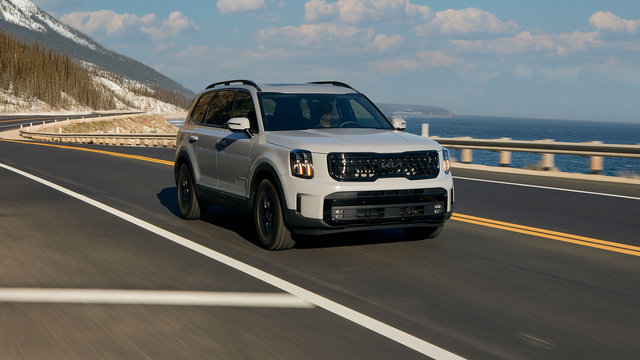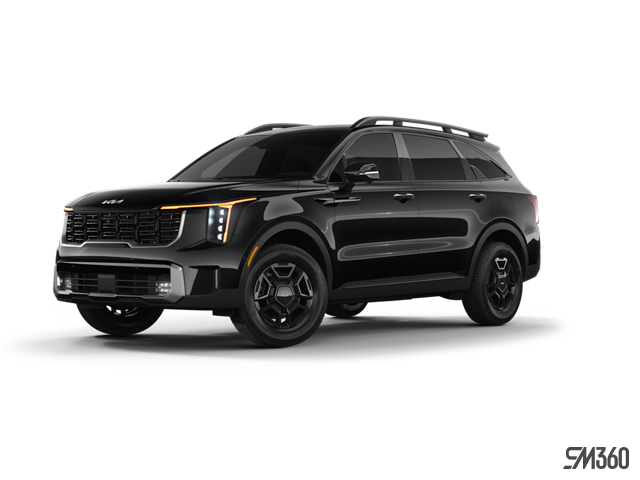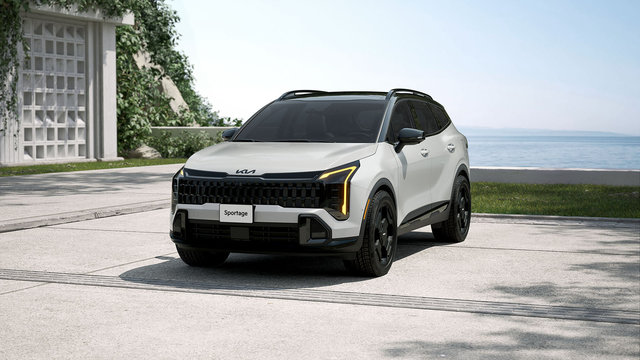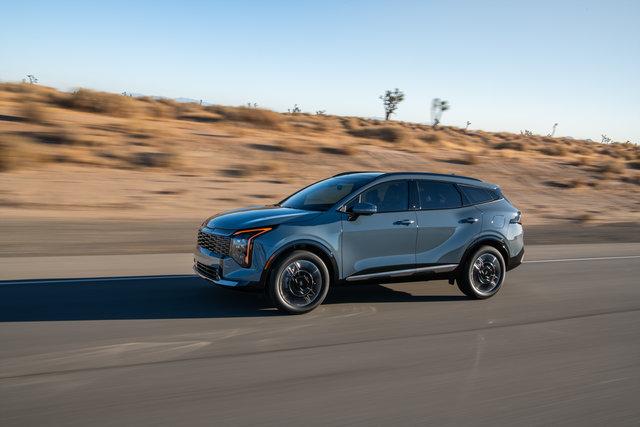Planning a winter getaway to Mont-Tremblant or the Laurentians? Choosing the right SUV can make all the difference when you're packing skis, snowboards, boots, and gear for the whole family. The 2026 Kia Sorento and 2026 Kia Sportage both offer versatile cargo solutions, but their capacities differ significantly depending on your needs. If you're comparing these two popular Kia SUVs for your...

The familiar stretch of Autoroute 40 between Laval and Quebec City becomes a different experience when your Kia's Highway Drive Assist (HDA) is engaged. Instead of constant adjustments to maintain your lane position and safe following distance, the system quietly takes over the repetitive aspects of highway driving, letting you focus on the scenery and your passengers' conversations during those long summer trips to the capital.
Highway Drive Assist represents a significant step beyond traditional cruise control, combining multiple technologies to create a semi-autonomous driving experience. The system maintains your set speed, keeps a safe distance from vehicles ahead, and actively steers to keep you centred in your lane—all while requiring your hands to remain on the wheel and your attention on the road.
How Highway Drive Assist Works
HDA combines three core technologies: Smart Cruise Control with Stop & Go, Lane Following Assist, and forward-facing radar and camera systems. The forward-facing camera continuously scans lane markings on both sides of your vehicle, while radar sensors monitor traffic ahead and to the sides. This dual-sensor approach provides the redundancy needed for safe operation at highway speeds.
When you activate HDA on a clearly marked highway, the system takes over steering inputs to keep you centred in your lane. If traffic slows, it automatically adjusts your speed to maintain the following distance you've selected. On stretches like the approach to Trois-Rivières where traffic frequently varies, this prevents the constant acceleration and braking that makes highway driving tiring.
The advanced version, Highway Drive Assist 2 (HDA2), adds navigation data integration and lane-change assistance. When you signal to change lanes, HDA2 can assist with steering inputs while monitoring blind spots and oncoming traffic. This feature proves valuable on busy sections of Autoroute 40 where merging traffic from Montreal creates complex lane-change scenarios.
Real-World Performance on Quebec Highways
Autoroute 40's varying conditions provide an ideal testing ground for HDA's capabilities. The system performs best on well-maintained sections with clear lane markings, such as the newer stretches between Montreal and Trois-Rivières. Here, HDA maintains precise lane positioning even through gentle curves, reducing the micro-corrections that contribute to driver fatigue.
Construction zones present challenges that demonstrate the system's limitations. When lane markings become unclear or temporary barriers create irregular lane configurations, HDA may disengage, returning control to the driver. The system provides clear warnings when this occurs, ensuring you're ready to resume manual control.
Weather conditions affect HDA's performance predictably. During Quebec's snowy winters, accumulated snow on lane markings can reduce the system's effectiveness. However, the radar sensors continue monitoring traffic ahead, so the Smart Cruise Control function typically remains active even when lane-keeping assistance is compromised.
Highway Drive Assist Key Features:
- Smart Cruise Control with Stop & Go capability
- Lane Following Assist for active steering input
- Forward-facing camera and radar sensor integration
- Hands-on Detection to ensure driver engagement
- Driver Attention Warning for fatigue monitoring
- Navigation-based functionality on HDA2 variants
Different HDA Levels Across Kia Models
Kia offers Highway Drive Assist across multiple models, with varying levels of sophistication. The base HDA system found on models like the Telluride and Carnival provides lane-keeping and adaptive cruise control. This system works well for straightforward highway driving but requires more driver input during lane changes.
HDA2, available on vehicles like the EV9 and select K4 trims, adds predictive capabilities using navigation data. The system can anticipate upcoming curves and adjust speed accordingly, providing smoother operation on winding sections of highway. The lane-change assistance feature actively helps with steering when changing lanes, though it still requires your signal activation and constant monitoring.
Hands-on Detection (HOD) is standard across all HDA variants, using sensors to detect when your hands leave the steering wheel. If the system doesn't sense your grip for several seconds, it provides escalating warnings—first visual, then audible, and finally a gentle steering vibration to ensure you remain engaged with the driving task.
Maximizing HDA Effectiveness
To get the most from Highway Drive Assist, understanding its optimal operating conditions helps set appropriate expectations. The system works best on divided highways with clear, consistent lane markings at speeds between 60 and 130 km/h. Autoroute 40's posted speed limits align well with these parameters, making it an ideal candidate for HDA use.
Regular maintenance ensures optimal performance. Keeping the windshield clean around the camera housing, typically located behind the rear-view mirror, prevents vision-related malfunctions. The front radar sensor, usually integrated into the front grille area, should remain clear of ice, snow, or debris that could affect its operation.
Driver positioning matters more with HDA than with traditional driving. The system assumes you're seated properly with both hands available for the steering wheel. Adjusting your seat and mirrors before engaging HDA ensures you can quickly resume manual control when needed.
|
Driving Condition |
HDA Performance |
Driver Requirements |
|---|---|---|
|
Clear highways, good weather |
Optimal - full lane-keeping and speed control |
Monitor system, hands on wheel |
|
Light rain, gentle curves |
Good - may require occasional manual input |
Increased attention to road conditions |
|
Construction zones, unclear markings |
Limited - frequent disengagement likely |
Ready to resume full manual control |
|
Heavy precipitation, poor visibility |
Not recommended - system may not engage |
Full manual driving required |
|
City streets, parking lots |
Not designed for use |
Manual driving only |
Understanding System Limitations
Highway Drive Assist enhances driving safety and comfort but doesn't create an autonomous vehicle. The system requires continuous driver attention and can't handle emergency situations, unexpected obstacles, or complex traffic scenarios. On Autoroute 40, this means staying alert for situations like wildlife crossings near forested areas or sudden weather changes.
The technology works within specific parameters designed for highway use. Sharp curves, steep grades, or unusual road conditions may cause the system to disengage temporarily. When this happens, clear visual and audible alerts ensure you're prepared to resume control immediately.
Lane-change assistance, where available, requires your active participation. The system won't change lanes automatically—you must signal your intention and verify the manoeuvre is safe. HDA2 provides steering assistance during the lane change but relies on your judgment for timing and safety assessment.
The Future of Highway Driving
Highway Drive Assist represents current production technology, delivering tangible benefits for long-distance driving while maintaining safety as the primary concern. For families planning summer trips from Laval to destinations across Quebec, HDA reduces driver fatigue and makes highway travel more comfortable for everyone.
The system's evolution continues with each model year, incorporating improved sensors and more sophisticated software. Future versions promise enhanced performance in challenging conditions and more seamless integration with navigation and traffic data.
Experience Highway Drive Assist firsthand at Lallier Kia Vimont, where you can test how this technology transforms your highway driving experience on familiar Quebec roads.
To learn more about the Highway Driving Assist, visit Kia.ca
Other Articles That May Interest You
The 2026 Kia Sportage Hybrid stands out in Canada's competitive compact SUV segment by delivering fuel efficiency, all-wheel-drive capability, and advanced technology. For eco-conscious drivers in Quebec seeking a practical family vehicle that doesn't compromise on performance or features, the Sportage HEV offers a strong case as Kia's leading compact SUV choice. With its refined hybrid...
Winter driving in Laval brings unique challenges—from icy highways to reduced visibility during snowstorms. The 2026 Kia Carnival Hybrid addresses these conditions with a comprehensive suite of safety technologies designed to protect your family when roads become unpredictable. From advanced collision prevention systems to heated features that maintain clear sightlines, this hybrid minivan...








